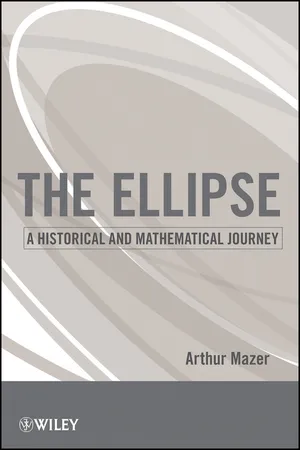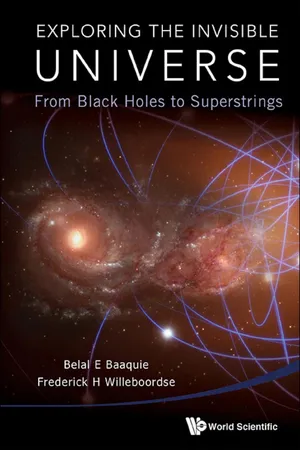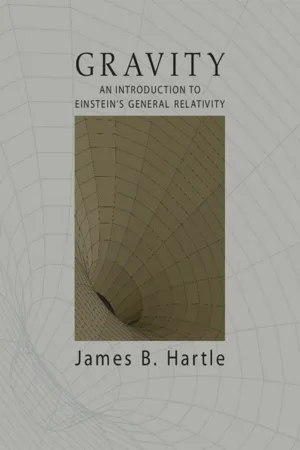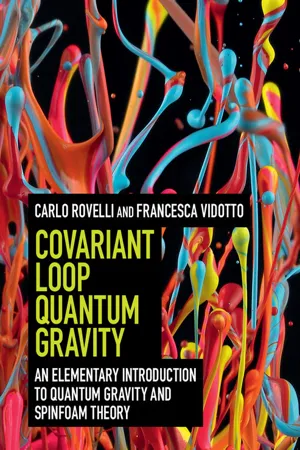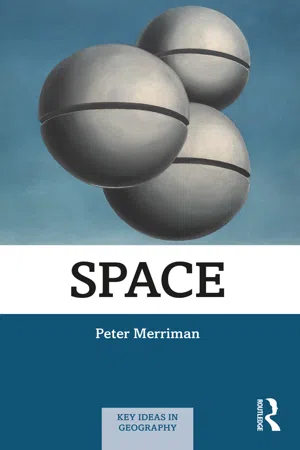Physics
3D Euclidean Space
3D Euclidean space refers to the three-dimensional space described by the Euclidean geometry, where the position of a point is specified by three coordinates. In physics, it is commonly used to represent the physical space we live in and to describe the position and movement of objects. This space is characterized by the three perpendicular axes - x, y, and z.
Written by Perlego with AI-assistance
Related key terms
1 of 5
9 Key excerpts on "3D Euclidean Space"
- eBook - ePub
The Ellipse
A Historical and Mathematical Journey
- Arthur Mazer(Author)
- 2011(Publication Date)
- Wiley(Publisher)
Greek geometers studied objects (squares, circles, triangles, and so on) and considered space as a boundless envelope that contains objects. A point can contain no objects and is zero dimensional. The shortest path between two points gives a line segment that can be extended endlessly into a line; the line is a one-dimensional space. Given two intersecting lines, the space generated by taking all the lines that are parallel to one while intersecting the other is a two-dimensional plane. From the two-dimensional plane and another line that intersects the plane in a single point, three-dimensional space may be generated by taking all the planes that are parallel to the initial plane while intersecting the additional line in a single point. The Greeks considered objects to be of one, two, or three dimensions.3.1.2 Euclidean Space in Higher DimensionsThe modern notion of Euclidean space is a generalization of three-dimensional Euclidean space into higher dimensions. While the concept of dimensions beyond 3 may seem foreign, in fact it is necessary to consider higher dimensions to describe many physical systems, even very simple ones. We give a description of the motion for a single rigid body as an example. Consider a dimension as an attribute associated with the rigid body’s motion. The motion has many attributes, such as location, velocity, orientation, and change in orientation; a description of the body’s motion requires a space that is an extension of physical space.The starting point is to locate the body’s position while at rest. The location of an object indicates the position of the object’s center of mass and is accordingly a single point. An object at rest has no degrees of freedom; its center of mass is fixed and the dimension of the space necessary to describe its position is 0; we can describe its position with a single point. If we allow the object to move in a line, say from left to right, the object can move along one degree of freedom; accordingly, the dimension of the space in which the object can move is l. Providing an additional degree of freedom so that the object can move from front to back, as well as left to right, the dimension of the space is 2. Finally, allowing the object to move in any direction, left to right, front to back, and up and down, the object has three degrees of freedom and the object can move in three dimensions. At most three numbers suffice to describe the location of an object at a given time. If we wish to designate the object’s location by time, a fourth number is needed, namely, the time. Accordingly, the dimension of the space where the object is described is 4. - eBook - ePub
Exploring The Invisible Universe: From Black Holes To Superstrings
From Black Holes to Superstrings
- Belal E Baaquie, Frederick H Willeboordse(Authors)
- 2015(Publication Date)
- WSPC(Publisher)
Chapter 3 The Geometry of Space How straight is straight? 3.1 The QuestionGeometry is usually understood to be the study of the shape, size and form of objects. A sphere is the geometrical shape of a billiard ball. One may proceed further and ask about the geometry of space itself. The space we move around in has a geometry, although we may not reflect upon its properties. Many of us remember the rudiments of the geometry of Euclid, in which there is only one straight line between two points, two straight lines intersect at a point and parallel lines do not meet. The rudimentary notions of Euclidean geometry have to be greatly enhanced in order to discuss the more complex geometrical concepts that arise in the study of our Universe’s spacetime.The concept of dimensionality is fundamental in the study of geometry. The space that we live in is three dimensional, since one needs three real numbers to specify a point in space; for example, to describe a cube of sugar, we have to provide its length, width and height. A major advance made in our understanding of Nature is that time itself can be described by a real number and clocks measure time in the number of seconds, which is a real number. Time is another dimension of Nature, lying in a direction perpendicular to all three space dimensions.When space and time are taken together, the Universe that we live in turns out to be a four dimensional spacetime, with three space dimensions and one time dimension. In this chapter, we examine the concepts of space and time in some detail with the intention of acquiring the understanding required for studying the structure and properties of our Universe’s spacetime. - eBook - PDF
Gravity
An Introduction to Einstein's General Relativity
- James B. Hartle(Author)
- 2021(Publication Date)
- Cambridge University Press(Publisher)
However some simple three-dimensional ge- ometries can be thought of as curved surfaces in a hypothetical four-dimensional Euclidean space. For example, the three-dimensional geometry analogous to the a sin θ θ a r 20 Chapter 2 Geometry as Physics two-dimensional sphere discussed before is the three-dimensional surface of a sphere in four dimensions—a three-sphere. If space had a fixed three-sphere ge- ometry, a journey in a straight line in any direction would eventually bring one back to the starting point. However, more detailed information about the geome- try of space can be determined locally. For example, it turns out that the volume inside a two-dimensional sphere of radius r in such a spatial geometry is given by V = 4π a 3 1 2 sin −1 r a − r 2a 1 − r a 2 1/2 (2.6a) ≈ 4π r 3 3 1 + corrections of order (r /a) 2 , for small r a , (2.6b) where a is the characteristic radius of curvature of the three-sphere geometry. For a two-sphere whose radius is much smaller than a, the volume-radius relation approaches the Euclidean flat-space result, as (2.6b) shows. If three-dimensional space had such a three-sphere geometry, the characteristic radius of curvature a could be determined by careful measurements of the radii and volume of two- spheres. As we will discover in Chapter 18, Einstein’s theory predicts this three- sphere geometry as one possibility for the spatial geometry of a uniform universe on very large distance scales. Box 2.2 on p. 17 describes one effort to survey space on these scales. 2.4 Specifying Geometry In addition to the geometry of the plane and the geometry of the sphere, there are an infinite number of other two-dimensional geometries. For example, there is the geometry on the surface of an egg or the geometry of the surface of a plane with a few hills on it. In three dimensions there are a similarly infinite number of geometries. - Howard Anton, Chris Rorres(Authors)
- 2014(Publication Date)
- Wiley(Publisher)
117 C H A P T E R 3 Euclidean Vector Spaces CHAPTER CONTENTS 3.1 Vectors in 2-Space, 3-Space, and n-Space 117 3.2 Norm, Dot Product, and Distance in R n 127 3.3 Orthogonality 138 3.4 The Geometry of Linear Systems 145 3.5 Cross Product 153 INTRODUCTION Engineers and physicists distinguish between two types of physical quantities— scalars, which are quantities that can be described by a numerical value alone, and vectors, which are quantities that require both a number and a direction for their complete physical description. For example, temperature, length, and speed are scalars because they can be fully described by a number that tells “how much”—a temperature of 20 ◦ C, a length of 5 cm, or a speed of 75 km/h. In contrast, velocity and force are vectors because they require a number that tells “how much” and a direction that tells “which way”—say, a boat moving at 10 knots in a direction 45 ◦ northeast, or a force of 100 lb acting vertically. Although the notions of vectors and scalars that we will study in this text have their origins in physics and engineering, we will be more concerned with using them to build mathematical structures and then applying those structures to such diverse fields as genetics, computer science, economics, telecommunications, and environmental science. 3.1 Vectors in 2-Space, 3-Space, and n-Space Linear algebra is concerned with two kinds of mathematical objects, “matrices” and “vectors.” We are already familiar with the basic ideas about matrices, so in this section we will introduce some of the basic ideas about vectors. As we progress through this text we will see that vectors and matrices are closely related and that much of linear algebra is concerned with that relationship. Geometric Vectors Engineers and physicists represent vectors in two dimensions (also called 2-space) or in three dimensions (also called 3-space) by arrows.- eBook - ePub
- Hermann Weyl(Author)
- 2013(Publication Date)
- Dover Publications(Publisher)
CHAPTER I EUCLIDEAN SPACE. ITS MATHEMATICAL FORMULATION ANDITS RÔLE IN PHYSICS§ 1. Deduction of the Elementary Conceptions of Space fromthat of EqualityJ UST as we fixed the present moment (“now”) as a geometrical point in time, so we fix an exact “here,” a point in space, as the first element of continuous spatial extension, which, like time, is infinitely divisible. Space is not a one-dimensional continuum like time. The principle by which it is continuously extended cannot be reduced to the simple relation of “earlier” or “later ”. We shall refrain from inquiring what relations enable us to grasp this continuity conceptually. On the other hand, space, like time, is a form of phenomena. Precisely the same content, identically the same thing, still remaining what it is, can equally well be at some place in space other than that at which it is actually. The new portion of Space S′ then occupied by it is equal to that portion S which it actually occupied. S and S′ are said to be congruent. To every point P of S there corresponds one definite homologous point P′ of S′ which, after the above displacement to a new position, would be surrounded by exactly the same part of the given content as that which surrounded P originally. We shall call this “transformation” (in virtue of which the point P′ corresponds to the point P) a congruent transformation. Provided that the appropriate subjective conditions are satisfied the given material tiling would seem to us after the displacement exactly the same as before. There is reasonable justification for believing that a rigid body, when placed in two positions successively, realises this idea of the equality of two portions of space ; by a rigid body we mean one which, however it be moved or treated, can always be made to appear the same to us as before, if we take up the appropriate position with respect to it. I shall evolve the scheme of geometry from the conception of equality combined with that of continuous connection—of which the latter offers great difficulties to analysis —and shall show in a superficial sketch how all fundamental conceptions of geometry may be traced back to them. My real object in doing so will be to single out translations - eBook - PDF
Understanding Geometric Algebra
Hamilton, Grassmann, and Clifford for Computer Vision and Graphics
- Kenichi Kanatani(Author)
- 2015(Publication Date)
- A K Peters/CRC Press(Publisher)
C H A P T E R 2 3D Euclidean Geometry 3D Euclidean geometry is usually described in terms of numerical vectors, i.e., column and row vectors. In this chapter, a vector is a geometric object equipped with direction and magnitude, not an array of numbers. Here, we present an “algebraic” description of 3D Euclidean geometry, representing objects by “symbols” and defining “operations” on them. From this viewpoint, we introduce the inner, the outer, and the scalar triple products of vectors. Then, we list expressions and relationships involving rotations, projections, lines, and planes. This chapter provides a basis of all the subsequent chapters. 2.1 VECTORS A vector is a geometric object that has “direction” and “magnitude”; one can imagine it as an “arrow” in space. Vectors represent the following quantities and properties: Displacements, velocities, and force Vectors specify in which direction, over what distance, and at what velocity things move or what force is acting. We are interested only in their directions and magnitudes; we are not concerned with the location of the starting point. Such vectors are called free vectors . Directions in space Vectors indicate orientations of lines and surface normals to planes. Only directions are important; magnitudes are ignored. Such vectors are called direction vectors . Since their magnitudes are irrelevant, they are usually multiplied by appropriate numbers to unit vectors with unit magnitude. Positions in space We fix a special point O , called the origin , and define the positions of points by their displacements from the origin O . Such vectors are called position vectors . Vectors whose starting points are specified are said to be bound . Positions vectors are bound to the origin O . The study of using and manipulating “vectors” for such different quantities and rela-tionships is called vector calculus , providing the basis of geometry, classical mechanics, and electrodynamics. - eBook - PDF
- Hartmut Prautzsch, Wolfgang Boehm(Authors)
- 2018(Publication Date)
- A K Peters/CRC Press(Publisher)
Chapter 16 The Euclidean Space 167 3 Replacing a gauge quadric by another quadric belonging to the same homothetic pencil means that all distances are multiplied by a common factor while all angles are left unchanged. 4 An affine map of the Euclidean space which leaves angles unchanged is a dilatation. 5 A proper Euclidean motion which has a fixed point c is called a rotation around the center c. 6 Every rotation in £ 3 has a line of fixed points. This line is called its axis. 7 Two subspaces A and B are called skew if A n B = 0 and A n B = {o}. 8 Let A and B be two skew subspaces given by On computing the volume of the parallelepiped spanned by a —b and the columns of A and B, one gets for the shortest distance between A and B 9 By definition, the zero vector is orthogonal to every vector. 17 Some Euclidean Figures The structure of a Euclidean space is not affected by Euclidean movements. Moreover, there are properties of figures which are invariant, i.e., there are rules for constructing the figures, and the properties depend on these rules, but they do not depend on the figures’ specific position in Euclidean space. Dropping a perpendicular from a point onto a plane is a simple example of such a construction. L iterature: Berger, Coxeter, Perdoe 17.1 The Orthocenter Several classical theorems on triangles are concerned with perpendiculars from a vertex onto the opposite side: Perpendiculars Consider a triangle abc. Let a, /3, 7 denote the corresponding angles. The perpendicular from c onto ab subdi vides a, b in the ratio tan/? : tana. O rthocenter From Ceva’s theorem in Section 12.1 it follows that the three altitudes of a triangle meet in a point d which is Chapter 17 Some Euclidean Figures 169 called the orthocenter of the triangle. Note that, for the three vertices and d, each of these four points is the or thocenter of the other three. - eBook - PDF
Covariant Loop Quantum Gravity
An Elementary Introduction to Quantum Gravity and Spinfoam Theory
- Carlo Rovelli, Francesca Vidotto(Authors)
- 2014(Publication Date)
- Cambridge University Press(Publisher)
PART II THREE-DIMENSIONAL THEORY 5 Three-dimensional euclidean theory In order to find a quantum theory for the gravitational field, we can apply the general structure devised in Chapter 2 to the theory defined in Chapter 3, discretized as explained in Chapter 4. Since the resulting theory includes a number of technical complications, in this chapter we first complete a simpler exercise: apply this same strategy to euclidean general relativity in three spacetime dimensions, recalled in Section 3.5. This exercise allows us to introduce a number of ideas and techniques that will then be used in the physical case, which is the lorentzian theory in four spacetime dimensions. There are major differences between general relativity in three dimensions and four dimensions. The foremost is that the 3d theory does not have local degrees of freedom: it is therefore infinitely simpler than the 4d theory. This is reflected in properties of the quantum theory that do not hold in the 4d theory. In spite of these differences, the exercise with the 3d theory is illuminating and provides insight into the working of quantum gravity, because in spite of its great simplicity the 3d theory is a generally covariant quantum theory of geometry. 5.1 Quantization strategy To define the quantum theory we need two ingredients: • A boundary Hilbert space that describes the quantum states of the boundary geometry. • The transition amplitude for these boundary states. In the small limit the transition amplitude must reproduce the exponential of the Hamilton function. To construct the Hilbert space and the transition amplitude, we proceed in steps. First we discretize the classical theory. Then we study the quantum theory that corresponds to the discretized theory. - Davies 1977 ).
N-Dimensional Spaces and Non-Euclidean Geometry
The ‘nature’ of space proved to be a hotly contested subject, but the different species of space advanced by Descartes, Newton, Leibniz, and other scientists and philosophers remained more-or-less Euclidean in their conception, in that spatial forms and geometries were seen to conform to Euclid’s key axioms and postulates, and spatial forms could be visually represented in two or three dimensions. One postulate, the ‘fifth’ or ‘parallel’ postulate (Box 3.1 ), had proved difficult to derive or prove, frustrating generations of mathematicians (Lanczos 1970 ), but significant advances were made in the early nineteenth century by a series of mathematicians (including Gauss, Bolyai, and Lobachevsky) exploring surface geometries which did not appear to conform to the fifth postulate due to their curvature. Whereas Euclidean geometric surfaces and spaces have a curvature of zero, the ‘hyperbolic’ and ‘elliptic’ spaces of non-Euclidean geometry have a constant negative and positive curvature, respectively.These new geometries appeared abstract and divorced from Euclidean visual and physical spaces, yet there was an earthly grounding to the mathematical reasoning behind some of these surface geometries, not least in geodesic surveys undertaken of the curved surface of the earth. In 1818, Karl Friedrich Gauss undertook a geodetic survey of Hanover on behalf of its new ruler, King George III of Britain, and there is no doubt that his practical experience of surveying large areas fuelled his mathematical interest in the geometry of curved surfaces.6 Just a few years after the survey, in 1825 and 1827, Gauss delivered two influential lectures investigating the general properties of curved surfaces in which he advanced his theorema egregium (or ‘remarkable theorem’) that ‘if a curved surface is developed upon any other surface whatever, the measure of curvature in each point remains unchanged’ (Gauss 1902 [1827] , p. 20). This idea was revolutionary, underpinning later advancements by his pupil Bernhard Riemann, as well as Albert Einstein’s general theory of relativity (Lanczos 1970 ). Riemann, in particular, took Gauss’ differential geometry of curved surfaces and created a general theory extended into n-dimensional spaces, developing ‘the general notion of multiply extended magnitudes (in which space-magnitudes are included)’ and exploring the geometry of spatial manifolds with four or more dimensions (Riemann 1873a , p. 14; 1873b). 7 Geometry was now being understood through complex mathematical theories and procedures which appeared to abstract and synthesise spaces, while the advances of Gauss and Riemann (as well as Euler, Listing, Poincaré and others) led to the development of the field of topology in the nineteenth and early twentieth centuries wherein the geometric properties of n-dimensional topological forms are preserved despite being continuously deformed through twisting, folding, scrunching, or stretching (see Box 8.2). Topological approaches to space would later inspire a series of mathematical approaches to space developed in ‘spatial science’ (e.g. Tobler 1962 ; Haggett 1965 ; Warntz 1966 ; Harvey 1969a ; Marchand 1973 ), as well as approaches to the psyche in Gestalt psychology, behavioural psychology and psychoanalysis (Lewin 1936 ; Piaget and Inhelder 1956 [1948] ; Blum and Secor 2011 ; Chapter 4 ), and post-structuralist investigations of non-linear socio-spatial relations in human geography and sociology (e.g. Mol and Law 1994 ; Hetherington 1997a
Index pages curate the most relevant extracts from our library of academic textbooks. They’ve been created using an in-house natural language model (NLM), each adding context and meaning to key research topics.
